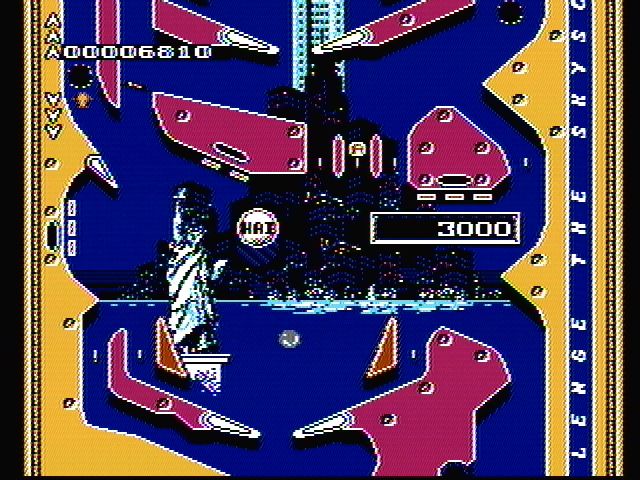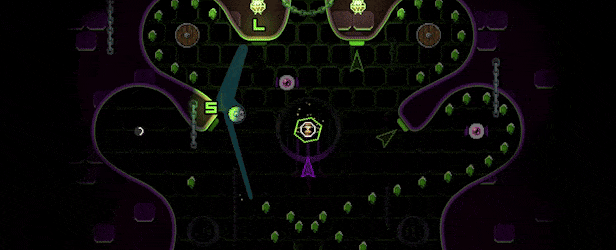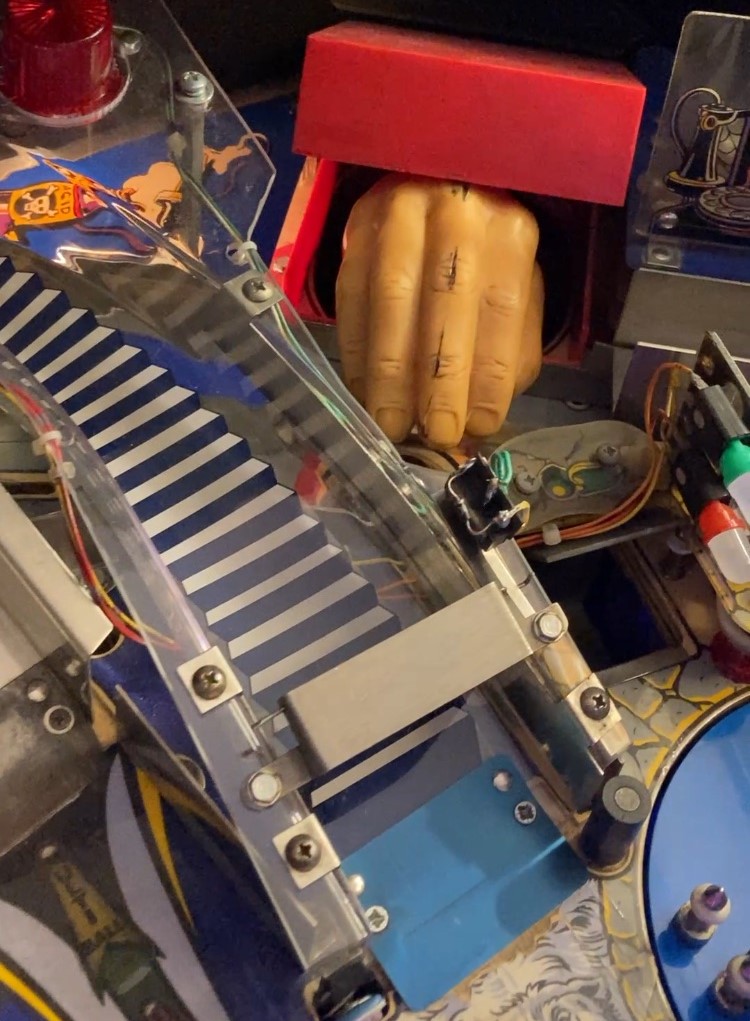#6: Spooky Silverballs

Awesome Balloween to you, scary shooters!
Robert here from The Ball is Wild. Admittedly, I’m usually not the biggest enthusiast when it comes to seasonal events and celebrations — horror stuff specifically. But when my research on pinball and Halloween started, I was in for a surprise pretty soon. Turns out spooky season is something that is not at all uncommon to pinball. And by that I’m specifically talking about the fun and (mostly) family friendly aspect of scare culture, which is what I like most. I’m not into disturbing horror, but all in for spiders, vampires, ghosts and monsters that won’t haunt your dreams for the next weeks but instead merge horror and laughter in equal amounts.

So this edition of The Ball is Wild 🪩 pinball culture newsletter is about creepy pinball recommendations, and some of them are also classics. This brings us to this edition’s editorial which is about the vertical table stacking of video pinball. It’s a wonderful tradition in digital silverball games that dates back to the mid-1980s and is still going strong. Best proof for that is a marbleous, I’m sorry, marvellous videogame that was released just this month called Pinball Spire. The Ball is Wild caught up with solo developer Tom Voros in an exclusive, elaborate interview. Let’s jump in!
IN THIS SIXTH EDITION:
Editorial: Vertical pinball stacking
Interview: A conversation with Tom Voros,
developer of Pinball SpireNews from the physical pinball world:
Video recommendations from Pinball ExpoBalloween: Creepy machines
Balloween: Spooky videoballs
From the archives: Person Pinball

EDITORIAL:
Vertical pinball stacking
Putting pinball machines on top of each other isn’t something that you should try out, ever. There were somewhat adjacent experiments with back-to-back multiplayer pinball in the past, and, of course, there are always rows and rows of machines in spacious halls from collectors where enthusiasts from everywhere around the planet drool over when they see photos or even be able to get to the respective places themselves. (By the way, since February this year, Rob Berk from Ohio is officially the person who owns the biggest collection of pinball machines in the world: 1.041. Even owning 41 machines would seem crazy to me!).
Putting digital pinball creations on top of each other is another thing entirely though. I would argue that this is the most traditional feature of video pinball games in general, and at the same time the most striking difference to physical pinball. It makes sense: To compensate for the lack of ball physics and unpredictability, as well as the whole haptic feel you get when you play on a physical machine, the experience goes wide instead. Like with levels in traditional videogames, video pinball links different playfields in all directions.
Going up, falling down
Commonly though, the way to go is up and down. The first game that has pulled this off is HAL Laboratory’s Rollerball, originally released for the MSX in 1984 and four years later ported to the Nintendo Entertainment System. HAL not only invented the vertically stacked video pinball concept, but also cemented it in the following years: 1989 saw the release of the amazing Revenge of the Gator for Game Boy (a title I loved as a kid) and Kirby’s Pinball Land for the same device four years later.

Games with stacked pinball levels were also trending on another videogame system from the late 80ies and early 90s, the PC Engine. The Alien-inspired Crush trilogy, always looking cool and bizarre at the same time, introduced not just amazing pinball games but also technical achievements at the time. Developed by now defunct Japanese company Naxat Soft, Alien Crush, Devil’s Crush and Jaki Crush were created and released between 1988 and 1992 and have dedicated fans to this day, despite the niche appeal. The modern hommages to the trilogy, Demon’s Tilt (2019) and Xenotilt (2023), take the stunning PC Engine retro look and feel and sprinkle it with modern technological marvels. These two games really take the history of the vertically stacked video pins to another level, pun intended.
Draining differently
As logic would have it, with pinball tables put on top of each other, mostly everything is connected (warp targets that transport you to secret levels don’t apply), and you only drain when the ball leaves the bottom playfield. This makes for an exciting atmosphere because you naturally want to stay in the higher levels, but sometimes have to descend in order to progress certain challenges and hit specific targets that are not available elsewhere.

If you are having a great run at these games, a ball can last for a long time. Conversely though, it feels even more crushing if you hit it off for maybe 20 minutes and then immediately lose the ball when it goes down the drain through several playfields. “Double drain” or “triple drain” hence gets an additional meaning here: It can refer to losing multiple balls during a multiball (as that’s what it usually means), but it can also stand for a ball within a table-stack video pin that goes to the gutter all the vertical way, from the shining top down to the gloomy deeps.
INTERVIEW:
A conversation with Tom Voros, developer of Pinball Spire
Early October saw the release of a brand new video pinball game I already hinted at in The Ball is Wild 🪩 Issue #2 in June when there was already a demo of the game available. Canadian solo developer Tom Voros worked on this game for two and a half years, being inspired by pin videogames from the 90ies. As tradition has it, Pinball Spire also features vertically stacked playfields and - as the name suggests - also puts them in a perfectly suitable building: a tower!

Pinball Spire is a fun and motivating puzzle pinball game with a neat and coherent pixel presentation. It features many little challenges that revolve around light and darkness, as well as finding certain switches or buttons you need to activate in order to be able to continue. Tom almost made the entire game by himself, which was a far cry from his previous videogame job where he was a programmer within a very large team at Ubisoft, working on (this pun happened accidentally, I swear) Far Cry 6. I was happy when Tom agreed to an interview with The Ball is Wild, and soon enough we had a relaxed and elaborate conversation which you can read in full length at TheBallisWild.net.
HEAVY MACHINES:
News from the physical pinball world:
Video recommendations from Pinball Expo
Mid October saw the 40th anniversary edition of one of pinball’s finest conventions: Pinball Expo. Though I haven’t been there yet myself, I feel that this is a classic event, meaning that it transcends eras and trends. Pinball Expo seems to encompass what pinball was, is and will be.
Pictures, videos, newsletter as well as experiences and opinions expressed on social media are all interesting, but what I mostly enjoy during and after the event is footage from the talks and panels that take place during Pinball Expo. Thanks to the efforts of the amazing team at Pinball News (another classic!), we now have a great number of videos from Pinball Expo 2024 to watch.

As I’m not a tech person but instead more interested in culture and history, I was mostly intrigued by the Collecting Pinball Machines from the Birth of Pinball to the 1930s panel. Also, it was great to watch Michael Schiess from Pacific Pinball Museum co-hosting a talk titled The Visible Pinball/Exhibits for Museums (Somewhat self-shaming side note: I conducted not just one, but two interviews with Michael throughout the last six years or so, and for reasons that are beyond me still haven’t published them yet. We might need to do a third conversation, Michael, and then we’d have … some kind of multi-interview that spans a tremendous timeframe all at once! Three’s a charm?).
Impossible not to mention is the two-parter panel with the crème-de-la-crème of pinball superstars from different areas: design, art, journalism, you name it. Stellar silverball senior Pat Lawlor is hosting this conversation, which is a guarantee for a fun and intimate history lesson in pinball culture. Don’t miss this: Here is 40 Years of Pinball Expo, Part 1, and Part 2.
BALLOWEEN:
Creepy machines
Throughout almost a decade of history, pinball saw many themes and topics come and go. Horror-themed machines have been introduced pretty late though: The mid and late 80ies saw the release of curiosities like Nosferatu, Mephisto or Terrific Lake. Spooky machines then gained traction in the 90ies, with well-known designs like Tales from the Crypt, Scared Stiff or Monster Bash.
But the biggest Balloween fan favorite is without a doubt the officially licenced The Addams Family machine. This is a modern classic from 1992 and often ranks among the best ten pinball designs ever made. Aside from the theme itself, it has fun und surprising features like The Thing, a hand which comes out of a box and grabs the ball via a magnet, or an auto-flip feature (Thing Flips) where the machine plays by itself for a moment.

The Addams Family is still the pinball game who sold the most units ever: over 20.000! This may not sound much compared to something like videogame sales, but don’t forget that pinball machines are big and expensive. They also weren’t initially produced for the home market but almost exclusively for operators who would put them on public display in arcades, restaurants, bars, and other places. Contemporary designs usually see the production of a few thousand units, in many cases less than that. Oh, and if you can’t find The Addams Family in the wilds, you could instead turn to The Munsters from 2019 — a game that can be considered a spiritual successor.
Continuing on physical machine Balloween, horror pinball tables were almost nowhere to be seen in the 2000s, but came back in the 2010s with America’s Most Haunted, the debut game of the ultimate Halloween pinball manufacturer, at least by name: Spooky Pinball (claim: “We Put the Boo in Boutique Pinball!”). Delivering on their promise, they also did Rob Zombie’s Spookshow International, Alice Cooper’s Nightmare Castle and John Carpenter’s Halloween. Stern Pinball aren’t specifically spooky, nevertheless they released Stranger Things, Ghostbusters and Elvira’s House of Horrors between 2016 and 2020.

BALLOWEEN:
Spooky videoballs
The most famous and highly recommended horror-themed video pinball games have already been mentioned in this very newsletter: It’s of course the H.R. Giger-inspired designs to be found in Alien Crush, Devil’s Crush and Jaki Crush released around 1990, and their modern hommages Demon’s Tilt and Xenotilt, which got published 30 years later.
Much stranger is a very early, very crudely presented video pin that looks more like an abstract geometrical painting than a horror game, but has at least a quite convincing title: Screamin’ Demon! (1983). About ten years later, Pinball Dreams became a success, and thus several subsequently developed digital pinball titles (Pinball Fantasies, Psycho Pinball, etc.) started to incorporate distinct tables that were separated from each other and needed to be launched individually. There you could find tables like Nightmare, Stones N Bones, or Tarantula. These designs were always part of a set of tables. It’s basically the same concept as we know it from today’s simulation frameworks such as Pinball FX.
Coming out of the 90ies and going into the 2020s: If you are looking for contemporary halloweeny video pinball games without any nostalgia or retro vibe, then you should definitely launch yourself into Pinball M (developed by Zen Studios of Pinball FX-fame). With the exception of the Duke Nukem table, almost every design here is spot-on horror and terror at its best: Dead by Daylight, The Thing, Chucky, Texas Chainsaw Massacre, you name it. The latest addition to Pinball M, just released a few days ago, is Camp Bloodbrook.

Finally, if you want something modern, but more indie and way less serious, there is Zombie Rollerz: Pinball Heroes, which is basically Plants vs. Zombies as a silverball game.
FROM THE ARCHIVES:
Person Pinball
Finishing up this edition of The Ball is Wild 🪩 pinball culture newsletter, let us slowly turn away from Balloween and turn to something more cheerful and fun instead.
I’m always on the lookout for quirky and entertaining pinball art and culture projects that play with the basic elements of pinball in many different ways. Person Pinball is the perfect example of joyful experimentation on the subject. Put together by stop-motion expert Aaron Hughes in 2011, the short description of this animation is simply “Passing pedestrians become pinball play”. No notes!
This was issue #6 of The Ball is Wild!
What did you like? Do you want to comment on something? Let me know!
You can send an email by hitting reply, or reach out on Bluesky, Mastodon, or Instagram.
By the way, we have a brand-new The Ball is Wild Instagram page, go check it out!

Back issues:
Issue #5: Balancing balls (30 September 2024)
Issue #4: Pinball in the public (31 August 2024)
Issue #3: Machine manipulation (29 July 2024)
Issue #2: Examining the pinball (1 July 2024)
Issue #1: Let’s get this ball rolling (10 June 2024)
General information about this newsletter and the person behind it is available at the front page.
If you like The Ball is Wild, why not recommend it to friends, family or colleagues who might be interested?
See you in November! 👋